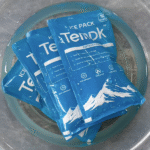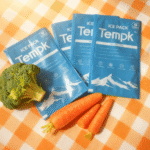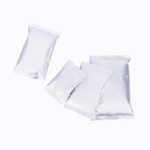Einweg-Trockeneisblöcke für den Versand: Best Practices und Trends in 2025
Einführung:
Versand temperaturempfindlicher Produkte, insbesondere verderbliche Waren, erfordert eine sorgfältige Planung, um die richtigen Bedingungen aufrechtzuerhalten. Einweg-Trockeneisblöcke sind hierfür eine zuverlässige und effiziente Lösung. In diesem Artikel, Wir werden untersuchen, wie Einweg-Trockeneisblöcke funktionieren, die besten Praktiken für deren Verwendung, und welche Trends die Zukunft von Trockeneis prägen 2025.

Warum sollten Sie sich entscheiden? Einweg-Trockeneisblöcke für den Versand?
-
Effektive und langanhaltende Kühlung: Trockeneisblöcke können Temperaturen bis zu −78,5 °C aufrechterhalten (–109,3 ° F.), Ideal für empfindliche Produkte wie Arzneimittel, Essen, und biologische Proben.
-
Kostengünstige Lösung: Einweg-Trockeneisblöcke sind eine kostengünstige Alternative zu wiederverwendbaren Kühlboxen und Gel-Packs, insbesondere für kurzfristige Sendungen.
-
Einfachheit und Komfort: Ohne Rücksendelogistik, Diese Blöcke bieten eine problemlose Lösung für einmalige Sendungen.
Hauptvorteile von Einweg-Trockeneisblöcken
-
Hält extrem niedrige Temperaturen aufrecht: Trockeneisblöcke halten Waren gefroren 24 Zu 72 Std., um sicherzustellen, dass verderbliche Gegenstände sicher bleiben.
-
Kein Schmelzwasser: Im Gegensatz zu Gelpackungen, was zu feuchtigkeitsbedingten Schäden führen kann, Trockeneis sublimiert direkt zu CO₂-Gas, hinterlässt keine Wasserrückstände.
-
Vielseitigkeit: Erhältlich in Blöcken, Pellets, und gepunktete Blätter, Sie können je nach Sendungsgröße und -dauer ausgewählt werden.
Beispiel aus der Praxis: Ein Pharmaunternehmen, das Impfstoffe verschickte, reduzierte den Verderb um 15% Verwendung von Einweg-Trockeneisblöcken, demonstrieren ihre Wirksamkeit in der temperaturempfindlichen Logistik.
Best Practices für die Verwendung von Einweg-Trockeneisblöcken
Die richtige Handhabung und Verpackung ist für die Optimierung der Leistung von Einweg-Trockeneisblöcken unerlässlich. Nachfolgend finden Sie die folgenden Schritte:
1. Dimensionierung Ihres Trockeneisblocks
Damit Ihre Sendung die richtige Temperatur behält, Es ist wichtig, die benötigte Trockeneismenge zu berechnen:
-
Faustregel: Für einen Versandzeitraum von 24 Stunden, Verwenden Sie 5–10 Pfund Trockeneis pro Karton. Je nach Isolationsqualität und Umgebungstemperatur anpassen.
-
Überlegungen: Längere Transporte oder heißere Klimazonen erfordern möglicherweise mehr Trockeneis, um optimale Bedingungen aufrechtzuerhalten.
Größenbeispiel
Für eine Sendung von 10 kg gefrorene Meeresfrüchte in einer 15-Liter-Isolierbox, Eine 48-stündige Fahrt durch gemäßigte Temperaturen würde ungefähr dauern 1.8 kg Trockeneis.
| Versandtyp | Versandzeit | Trockeneis-Anforderung | Vorteile |
|---|---|---|---|
| Gefrorene Meeresfrüchte | 48 Std. | 1.8 kg | Stellt sicher, dass gefrorene Waren unversehrt ankommen |
| Pharmazeutika | 72 Std. | 7.5 kg | Hält ultrakalte Temperaturen aufrecht und verhindert Verderb |
2. Wählen Sie die richtige Verpackung
Stellen Sie sicher, dass Ihre Sendung gut isoliert ist. Verwenden Sie isolierte Behälter, die den kalten Temperaturen von Trockeneis standhalten und eine schnelle Sublimation verhindern. Erwägen Sie die Verwendung vakuumisolierter Paneele (VIP) oder expandiertes Polystyrol (EPS) für bessere Leistung.
3. Sicherheits- und Entsorgungsaspekte
Der Umgang mit Trockeneis erfordert Sicherheitsvorkehrungen:
-
Tragen Sie isolierte Handschuhe: Um Erfrierungen zu vermeiden.
-
Stellen Sie eine ordnungsgemäße Belüftung sicher: Trockeneis untermauert in Co₂ -Gas, die sich in verschlossenen Behältern ansammeln und einen Druckaufbau verursachen können.
-
Entsorgung: Sobald das Trockeneis sublimiert ist, Entsorgen Sie es an einem gut belüfteten Ort, um eine CO₂-Ansammlung zu vermeiden. Entsorgen Sie Trockeneis niemals in geschlossenen Räumen oder im Abfluss.
Trends im Trockeneisversand für 2025
Die Kühlkettenlogistikbranche entwickelt sich mit neuen Technologien und Innovationen bei Verpackungsmaterialien weiter. Hier erfahren Sie, was die Zukunft von Einweg-Trockeneisblöcken antreibt:
1. Intelligente Verpackung und IoT-Überwachung
Intelligente Verpackungslösungen mit IoT-Sensoren erfreuen sich immer größerer Beliebtheit, Ermöglicht die Temperaturverfolgung während des Transports in Echtzeit. Diese Systeme helfen Unternehmen, Sendungen zu überwachen und anzupassen, Reduzierung des Verderbs und Verbesserung der Zuverlässigkeit.
2. Nachhaltige Praktiken
Da die Nachfrage nach umweltfreundlichen Lösungen wächst, Unternehmen wenden sich Hybridsystemen zu, die Trockeneis mit Phasenwechselmaterialien kombinieren (PCMs) CO₂-Emissionen zu reduzieren und die Wirtschaftlichkeit zu verbessern.
3. Fortschritte bei Isoliermaterialien
Neue Isolationstechnologien, wie vakuumisolierte Paneele (VIP), Es wird erwartet, dass sich der Bedarf an großen Mengen Trockeneis verringert, Verbesserung der Kosteneffizienz von Sendungen und Reduzierung der Umweltbelastung.
Sicherheitsvorschriften und Einhaltung
Der Versand von Trockeneis erfordert die Einhaltung gesetzlicher Standards. Zu den wichtigsten Richtlinien gehören::
-
IATA-Richtlinien: Verpackungen mit Trockeneis müssen als gekennzeichnet sein “Kohlendioxid, Solide (Trockeneis), UN1845” und erfüllen die IATA-Verpackungsvorschriften 954.
-
DOT-Vorschriften: Trockeneis muss in belüfteten Behältern verpackt werden, und Gewichtsgrenzen müssen eingehalten werden, normalerweise nicht mehr als 5.5 lbs (2.5 kg) pro Paket bei Luftversand.
Die Nichteinhaltung dieser Vorschriften kann zu Verzögerungen und Bußgeldern führen.
4. Kosten und Nachhaltigkeit von Einweg-Trockeneisblöcken
Für kurzfristige Lieferungen ist Trockeneis oft eine kostengünstigere Lösung im Vergleich zu wiederverwendbaren Kühlboxen oder Gel-Packs. Jedoch, Mehrere Faktoren können die Kosten beeinflussen:
-
Massenkauf: Der Kauf von Trockeneis in großen Mengen kann die Stückkosten senken.
-
Isolationsqualität: Durch die Verbesserung der Isolierung wird der Trockeneisverbrauch gesenkt, auf lange Sicht Kosten sparen.
-
Umweltfreundliche Beschaffung: Einige Lieferanten verwenden inzwischen CO₂, das aus erneuerbaren Quellen gewonnen wird, Dies trägt dazu bei, die Umweltauswirkungen der Trockeneisproduktion zu reduzieren.
Praktische Anleitung
-
Verhandeln Sie mit Lieferanten: Sichern Sie sich langfristige Verträge, um Preisschwankungen abzumildern.
-
Investieren Sie in eine bessere Isolierung: Verwenden Sie hochwertige Isoliermaterialien, um die Menge an benötigtem Trockeneis zu minimieren.
Häufige Fragen zu Einweg-Trockeneisblöcken für den Versand
Q1: Wie lange halten Einweg-Trockeneisblöcke meine Sendung gefroren??
Mit ordnungsgemäßer Isolierung und Verpackung, Einweg-Trockeneisblöcke können gefrorene Temperaturen aufrechterhalten 24-72 Std., Abhängig von der Größe und den Bedingungen der Sendung.
Q2: Wie entsorge ich unbenutztes Trockeneis nach dem Versand??
Sobald das Trockeneis zu Gas sublimiert ist, Entsorgen Sie es an einem gut belüfteten Ort. Entsorgen Sie es niemals in einem geschlossenen Raum.
Q3: Wie bestimme ich die Menge an Trockeneis, die für meine Sendung benötigt wird??
Die allgemeine Richtlinie lautet 5-10 LBS Trockeneis pro 24 Stunden des Versands. Je nach Isolierung anpassen, Umgebungstemperatur, und die Dauer der Sendung.
Schlussfolgerung und nächste Schritte
Einweg-Trockeneisblöcke sind eine effektive und kostengünstige Lösung für den Versand temperaturempfindlicher Produkte. Indem Sie die in diesem Artikel beschriebenen Best Practices befolgen, Sie können für Sicherheit sorgen, zuverlässig, und kostengünstiger Versand.
Nächste Schritte:
Bereit für den Einsatz von Trockeneisblöcken in Ihrem Kühlkettenversand? Kontaktieren Sie uns für eine persönliche Beratung, und lassen Sie uns Ihre Logistikstrategie optimieren.
Über Tempk
TEMPK ist ein führender Anbieter von Kaltketten -Logistiklösungen, spezialisiert auf Trockeneisblöcke, Gelpackungen, und isolierte Behälter. Unser Ziel ist es, Unternehmen dabei zu helfen, sensible Produkte sicher und effizient zu versenden. Kontaktieren Sie Tempk noch heute, um Ihre Versandprozesse zu verbessern.























